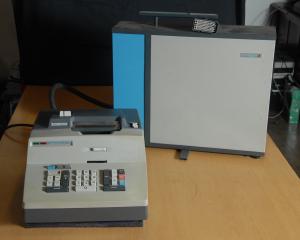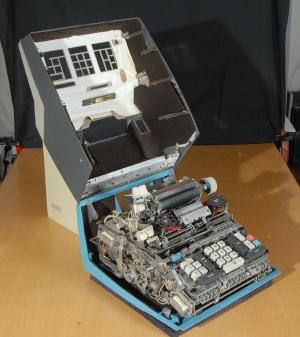Monroe EPIC 3000 Calculator
The EPIC 3000 is a weird first-generation hybrid machine. Monroe was one of the leading US mechanical calculator companies and the EPIC machines (EPIC 2000 and EPIC 3000) were developed in the early-mid 1960s as a response to the correctly-identified threat that electronics would pose to the mechanical calculator business.
Monroe had established an electronic computer business in the 1950s (see the Monrobot entry in the Computers section) and this should have alerted them to the potential for electronics to displace mechanical calculators. The computer division should also have been able to supply established electronic design and construction engineers. All the elements seem to be in place for Monroe to transition from leadership in mechanical calculators to leadership in electronic calculators, with the EPIC machines as the first step.
The EPIC machines however are a weird hybrid of forward-looking electronic logic with backward-looking mechanical interface. The desk units are nice and modern-looking but contain thousands of mechanical parts that clatter like old-school mechanical calculators and require the same level of cleaning and maintenance. The sleek and silent floor unit tends to be overlooked, except as a reminder that the desk unit is not actually self-contained.
Display technology was one of the biggest problems for first-generation designers. Friden (another leading mechanical calculator maker) spent time and money commissioning a Stanford University based consultancy to develop the CRT display that was used in the Friden EC-130. Monroe chose to use their in-house mechanical expertise for user interface, perhaps intending that the printed record of entries and results would be an additional sales point. The electro-mechanical hybrid was not successful and has had to wait over fifty years to develop (perhaps) some Steampunk appeal.
It is interesting to note that of the three leading US mechanical calculator companies, Friden and Monroe both developed first-generation electronic calculators that were unique and interesting but did not become successful product lines. Friden and Monroe did not continue calculator development after their first attempts, becoming resellers of Japanese machines.
- Friden left the calculator business in the mid 1970s, as prices fell and calculators became cheap commodity products
- Monroe continued as a reseller of calculators and general office equipment until the early 2000s
- Burroughs, the third mechanical calculator company, skipped the in-house development stage and sold Burroughs-branded Japanese machines in the late 60s and early 70s, leaving the calculator business in the late 1970s.





